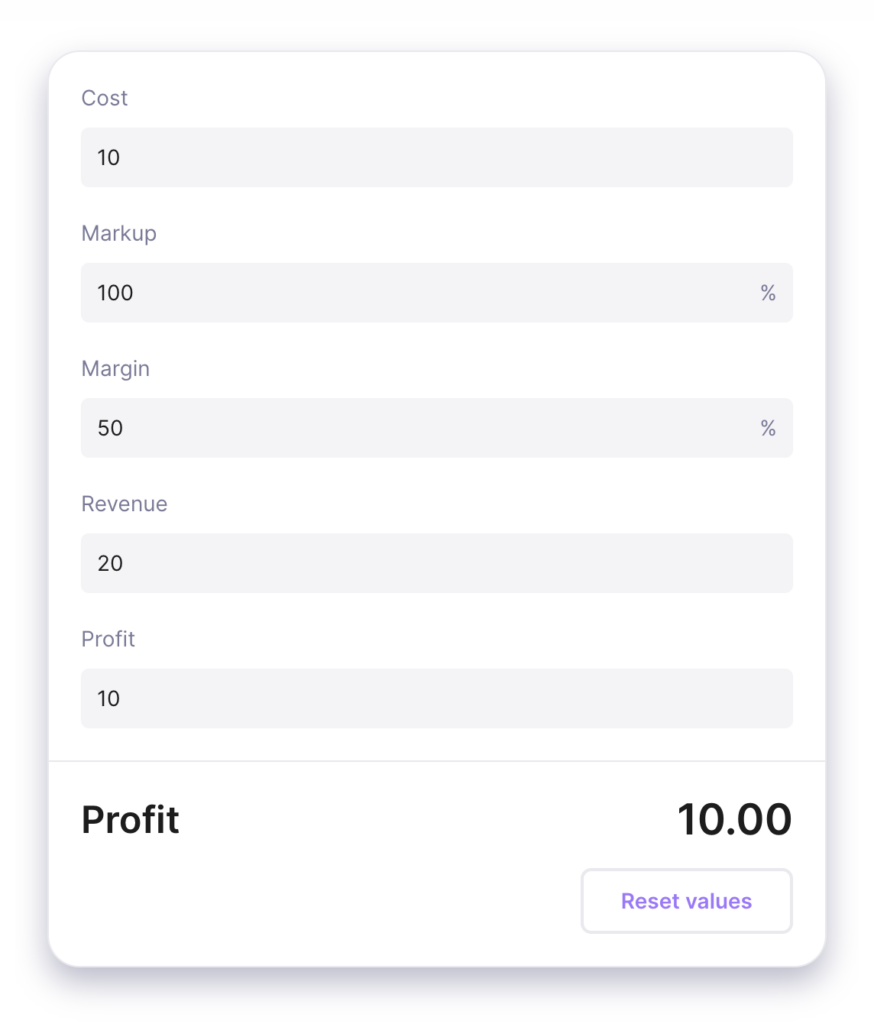Use the free Markup Calculator to:
- Calculate the selling price and run a financial analysis
- Set the competitive price of a product using percentage markup to build pricing strategies
- Manage product costs and other expenses
📈 Boost your markup with time tracking! Start tracking time for FREE

Cost
Simply input the price cost of the product. This might include production costs, purchase price, overhead costs, unit cost, and cost of goods sold (COGS).

Markup
Determine the desired markup percentage which is the increase you want to apply to the cost price to set the selling price of your product. Consider factors such as industry norms, competition, desired gross margin, and desired profit margins to determine an appropriate markup percentage.

Margin
The profit margin is calculated automatically based on the desired markup percentage. Although it’s preset, you can change this value manually to adjust the markup calculation according to the desired total revenue. Ensure to account for both fixed and variable costs when adjusting the markup calculation. Please note: The margin value cannot be higher than 100%.
Example:
- Enter the cost price, i.e. $40
- Define the desired markup percentage, i.e. 20%
- Let the Markup Calculator calculate: Margin, Revenue, and Profit.
Additional tips:
- To calculate markup, start by inserting the cost price and the margin.
- To calculate the selling price based on the desired markup percentage, start by entering the markup ratio in the Markup field.
- To calculate markup correctly, ensure that you consistently use either gross or net values for both cost price and selling price.

Service charges
When pricing services like consulting or freelance work, to cover costs and ensure profitability.

Project bidding
Estimating project costs and setting bids that cover expenses and include a profit margin.

Financial planning
Analyzing the impact of different markup percentages on overall profitability and revenue projections.

Retail pricing
When setting the selling price for new products in a retail store to ensure they cover costs and achieve the desired profit margin.

Wholesale pricing
When determining the selling price for bulk products sold to other businesses, ensuring a profitable margin over production costs.

E-commerce
When setting competitive prices for online products that factor in costs such as shipping, handling, and marketplace fees, ensuring profitability.


What’s the markup definition?
Markup is the amount a business adds to the cost of a product to set its selling price. For example, if a store buys a shirt for $20 and wants to sell it for $30, the $10 difference is the markup. For wholesale businesses, the markup is often calculated based on the wholesale price to ensure profitability.
What’s the difference between markup and margin?
Markup is the amount added to the cost price to determine the selling price, whereas margin is the portion of the selling price that represents profit.
What’s the markup formula?
The markup formula is:
Markup = Selling price – Cost price
It’s simply the difference between the selling price of a product and its cost price. So, if you subtract the cost price from the selling price, what you’re left with is the markup, which represents the additional amount added to the cost price to determine the selling price.
Why the profit margin cannot be higher than 100%?
Profit margin is calculated as the ratio of net profit to revenue, expressed as a percentage. If the net profit exceeds the revenue (selling price), it would result in a profit margin greater than 100%, which is not logically possible.
What is the markup price?
The markup price is the final selling price of a product after adding the markup to the cost price.


